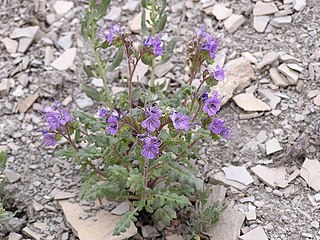
Phacelia campanularia is a species of flowering plant in the borage family, Boraginaceae, known by the common names desertbells, desert bluebells, California-bluebell, desert scorpionweed, and desert Canterbury bells. Its true native range is within the borders of California, in the Mojave and Sonoran Deserts, but it is commonly cultivated as an ornamental plant and it can be found growing elsewhere as an introduced species.

Phacelia fimbriata, the fringed phacelia, is a spring flowering wildflower of the genus Phacelia found in the highland woods of southeastern United States including the Great Smoky Mountains.

Phacelia purshii, known by the common names Miami mist, scorpionweed, and purple scorpionweed, is a spring flowering annual forb with blue, lavender, violet, or nearly white flowers in the Boraginaceae (borage) family that is native to eastern and central North America.

Frederick Vernon Coville was an American botanist who participated in the Death Valley Expedition (1890-1891), was honorary curator of the United States National Herbarium (1893-1937), worked at then was Chief botanist of the United States Department of Agriculture (USDA), and was the first director of the United States National Arboretum. He made contribution to economic botany and helped shape American scientific policy of the time on plant and exploration research.

Phacelia sericea, the silky phacelia or blue alpine phacelia, is a showy perennial species of Phacelia endemic to western North America. It grows mainly at subalpine to alpine elevations in forest openings or above treeline among rocks and sand. Sericea comes from the Latin sericeus, or silky, referring to the fine hairs on the leaves and stem.

Enceliopsis covillei, known by the common name Panamint daisy, is a rare North American desert species of flowering plant in the family Asteraceae.

Howellanthus is a monotypic genus of flowering plants in the borage family containing the single species Howellanthus dalesianus, commonly known as Scott Mountain phacelia or Howell's phacelia. Until 2010 the plant was known as Phacelia dalesiana. It is endemic to the southern Klamath Mountains of northern California, including the Scott Mountains for which it is named. It grows in mountain forests and meadows often on serpentine soils.

Phacelia insularis, the coast phacelia is a rare species of phacelia. It is endemic to California, where it has a disjunct distribution.
Phacelia inundata is a species of phacelia known by the common names playa yellow phacelia and playa phacelia. It is native to the Modoc Plateau and surrounding areas in Oregon, western Nevada, and northeastern California, where it grows in the alkaline soils of playas and dry lakebeds.

Phacelia linearis, the linear-leaved phacelia or threadleaf phacelia, is a species of phacelia.

Phacelia ramosissima is a species of phacelia known by the common name branching phacelia. It is native to western North America from British Columbia to California and the Southwestern United States, where it can be found in many types of habitat.

Phacelia viscida is a species of phacelia known by the common names sticky phacelia and tacky phacelia.

Sidalcea covillei is an uncommon species of flowering plant in the mallow family known by the common names Owens Valley sidalcea, and Owens Valley checkerbloom. It is endemic to the Owens Valley of Inyo County, California, where it grows on alkali flats and in alkaline meadows and springs. While it is limited to this single valley, it is known from 42 sites there, and several populations are relatively large, but are greatly diminished by historical standards.

Phacelia argillacea is a rare species of flowering plant in the borage family known by the common names clay phacelia and Atwood's phacelia. It is endemic to Utah in the United States, where it is known only from one canyon in Utah County. It is "one of Utah's most endangered species"; it is "one of the nation's rarest plants" and is federally listed as an endangered species of the United States.

Phacelia formosula is a rare species of flowering plant in the borage family known by the common name North Park phacelia. It is endemic to the state of Colorado in the United States, where it is known only from the North Park region in Jackson County. It is threatened by a number of human activities, such as motorcycle and off-road vehicle use in its habitat. It is a federally listed endangered species of the United States.
Senecio ertterae is a species of flowering plant in the aster family known by the common name Ertter's ragwort. It is endemic to Oregon, United States.

Phacelia covillei is a North American species of annual forbs in the borage family. It is native to the eastern and central United States in scattered locations from Missouri to Maryland and North Carolina.

Phacelia dubia is an annual forb native to the eastern United States, that produces cream colored or light blue flowers in early spring.
Phacelia cronquistiana is a plant species native to Utah and Arizona, known only from Kane and Mohave Counties. It occurs in sagebrush and Pinus ponderosa forests at elevations of 1,900–2,100 m (6,200–6,900 ft).
















